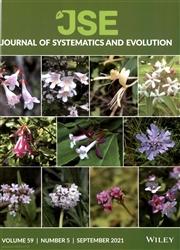欧亚大陆新生代Ampelopsis和Nekemias叶(葡萄科,Ampelopsideae):古生物地理学和古气候的影响
IF 3.7
1区 生物学
Q1 Agricultural and Biological Sciences
引用次数: 0
摘要
我们描述了产自西班牙塞韦拉(Cervera)侏罗纪的一个新的Ampelopsideae(葡萄科)物种Nekemias mucronata sp.nov.,并对最初描述自德国的另一个化石物种Ampelopsis hibschii进行了修订。通过与现生Ampelopsideae的比较发现,北美物种Nekemias arborea与Nekemias mucronata最为相似,而东地中海的Ampelopsis orientalis是A.我们对化石数据的研究表明,在始新世,欧亚大陆出现了 4 个 Ampelopsideae 物种,即捷克共和国的 N. mucronata、哈萨克斯坦的 A. hibschii 和远东的两个化石物种(Ampelopsis cercidifolia 和 Ampelopsis protoheterophylla)。在渐新世,一个新物种 Ampelopsis schischkinii 出现在哈萨克斯坦;与此同时,N. mucronata 向东和向南扩散,A. hibschii 主要生长在中欧。在渐新世晚期,N. mucronata 成为伊比利亚半岛的孑遗植物,而 Nekemias 可能在欧亚大陆西部一直延续到中新世晚期("Ampelopsis" abkhasica)。hibschii 的最后一次出现是在保加利亚的中新世中期,可能是湿温带类群的避难所,同时出现的还有 Ampelopsis aff.鲤科动物的遗骸表明,这一品系至少在欧洲一直存在到更新世。我们的数据证实了以前的观点,即北大西洋和白令陆桥是 Ampelopsideae 的重要扩散路线。不过,这种扩散可能发生在古新世,而不是以前认为的新近纪。在欧亚大陆西部仅有一个东方蛙属物种存活下来,这似乎与生物群落的迁移有关。本文章由计算机程序翻译,如有差异,请以英文原文为准。
Cenozoic Ampelopsis and Nekemias leaves (Vitaceae, Ampelopsideae) from Eurasia: Paleobiogeographic and paleoclimatic implications
We describe a new species of Ampelopsideae (Vitaceae), Nekemias mucronata sp. nov., from the Rupelian of Cervera (Spain) and revise another fossil species, Ampelopsis hibschii, originally described from Germany. Comparison with extant Ampelopsideae suggests that the North American species Nekemias arborea is most similar to Nekemias mucronata while the East Mediterranean Ampelopsis orientalis is the closest living relative of A. hibschii. Our review of fossil data indicates that, during the Eocene, four species of Ampelopsideae occurred in Eurasia, that is, N. mucronata in the Czech Republic, A. hibschii in Kazakhstan, and two fossil species in the Far East (Ampelopsis cercidifolia and Ampelopsis protoheterophylla). In the Oligocene, a new species, Ampelopsis schischkinii, appeared in Kazakhstan; meanwhile, N. mucronata spread eastwards and southwards, and A. hibschii mainly grew in Central Europe. In the late Oligocene, N. mucronata became a relict in the Iberian Peninsula and Nekemias might have persisted in Western Eurasia until the latest Miocene (“Ampelopsis” abkhasica). The last occurrence of A. hibschii was in the Middle Miocene in Bulgaria, probably a refuge of humid temperate taxa, along with Ampelopsis aff. cordata. Carpological remains suggest that this lineage persisted in Europe at least until the Pleistocene. Our data confirm previous notions of the North Atlantic and Bering land bridges being important dispersal routes for Ampelopsideae. However, such dispersion probably occurred during the Paleogene rather than the Neogene, as previously suggested. A single species of Ampelopsideae, A. orientalis, has survived in Western Eurasia, which appears to have been linked to a biome shift.
求助全文
通过发布文献求助,成功后即可免费获取论文全文。
去求助
来源期刊

Journal of Systematics and Evolution
Agricultural and Biological Sciences-Ecology, Evolution, Behavior and Systematics
CiteScore
7.40
自引率
8.10%
发文量
1368
审稿时长
6-12 weeks
期刊介绍:
Journal of Systematics and Evolution (JSE, since 2008; formerly Acta Phytotaxonomica Sinica) is a plant-based international journal newly dedicated to the description and understanding of the biological diversity. It covers: description of new taxa, monographic revision, phylogenetics, molecular evolution and genome evolution, evolutionary developmental biology, evolutionary ecology, population biology, conservation biology, biogeography, paleobiology, evolutionary theories, and related subjects.
 求助内容:
求助内容: 应助结果提醒方式:
应助结果提醒方式:


